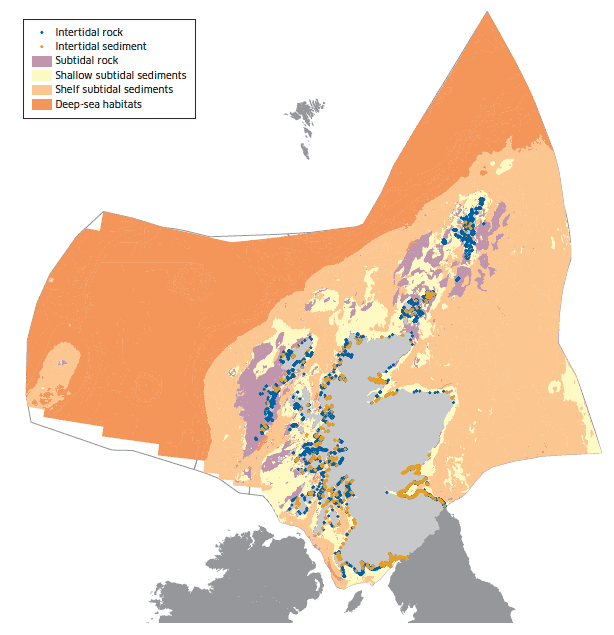Scotland's Marine Atlas: Information for The National Marine Plan
Scotland's Marine Atlas is an assessment of the condition of Scotland's seas, based on scientific evidence from data and analysis and supported by expert judgement.
CHAPTER 04 HEALTHY AND BIOLOGICALLY DIVERSE
INTRODUCTION
The Healthy and Biologically Diverse Seas chapter describes the range of habitat types and key species groups, their distribution and characteristics in Scotland's seas. It is intended to inform the national marine plan and is the basis upon which more detailed descriptions can be made at different scales. It will also serve to highlight key knowledge gaps and help focus and prioritise the deployment of future resources.
Scotland's seas are positioned between subpolar and subtropical influences and support a spectacular and diverse assemblage of habitats and species. There remains much to be discovered about the marine wildlife of Scotland but current best estimates suggest there are around 6,500 species of animals and plants (excluding the microbial flora) in Scotland's seas. (1)
An introductory section reviews the current status of nature conservation protection around the coast and in the sea. There are also sections that outline the scale of non-native invasions and those species that are considered only occasional visitors to Scotland's seas but which might be good indicators of changing conditions.
The majority of sections describe the key habitat types and species and highlight a range of Priority Marine Features. These are species and habitats that have been identified through a scientific evaluation of Scotland's marine biodiversity (2) and the list is being finalised by SNH and JNCC. The Priority Marine Features represent species and habitats of marine conservation importance for which it would be appropriate to use both area based and non-area based mechanisms to achieve better protection, and for which action will be prioritised via a three-pillar approach, i.e. species measures, site-based measures, and wider seas policies and measures as set out in Marine Scotland's Marine Nature Conservation Strategy.
Furthermore a second list of Marine Protected Area ( MPA) search features has been compiled. These mostly comprise the Priority Marine Features for which it is considered MPAs are an appropriate conservation measure. The full methodology to be adopted for the selection of MPAs and the development of the MPA network are set out in Marine Protected Areas in Scotland's Seas - Guidelines on the selection of MPAs and development of the MPA network (Marine Scotland, 2011) (3).
Information sources
The descriptions of the Priority Marine Features and the pressures they are facing are derived from a report prepared for SNH, Descriptions of Priority Marine Features in the seas around Scotland(4), based on MarLIN (Marine Life Information Network), FishBase, AlgaeBase and other specialist sources. The information on species distributions was derived from a range of sources including MarLIN, JNCC and Agency databases, NBN, OSPAR, the Shark Trust, etc.. Additional information on the distribution of fish species was obtained from Marine Scotland-Science, ICES, Defra, SEPA and NASCO. Seal numbers and distribution data were provided by the Sea Mammal Research Unit at St Andrews University. The seabird data are derived from the Seabird Monitoring programme which is led and coordinated by the JNCC in partnership with others whilst the waterbird data are from the Wetland Birds Survey. The maps of the distribution of the broad habitat types were produced by JNCC and are based on a combination of survey data and modelling. The maps showing the distribution of the individual Priority Marine Features are based on a number of datasets:
- SNH Marine Nature Conservation Review dataset
- SNH Marine Recorded database of additional surveys
- JNCC/ NBN Marine Recorded database
- MESH data layers
- Defra MPA layers project ( MB0102)
- DASSH (Archive of Marine Species and Habitats Data) data holdings.
Additional data on certain species such as sharks and rays were provided by the Shark Trust.
Modelled distribution of broad habitats

There is a problem
Thanks for your feedback